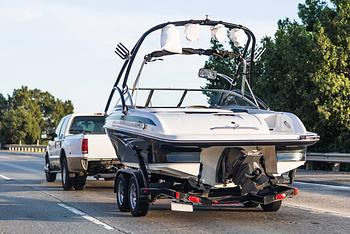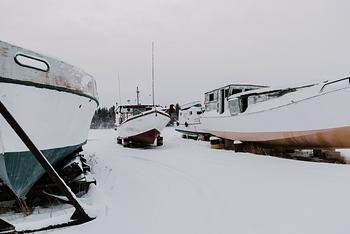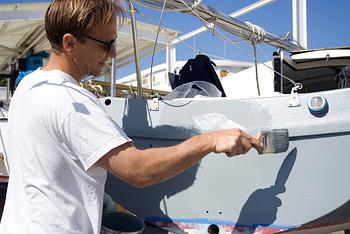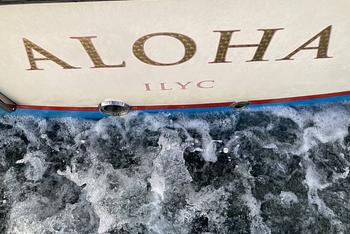Driving a boat and driving a car are very different and the mechanics and skills for driving each vary considerably, the consequences of speeding can be just as dangerous for both forms of transport. Likewise, a car or boat driver must stay alert and situationally aware at all times, anticipating what will happen next.
Speeding in a boat is not often considered to be the danger that it is, but according to the US Coast Guard, in 2022, there were 4,040 boating accidents in the United States that involved 636 deaths and 2,222 injuries. These are sobering statistics, especially knowing that most could have been avoided by better speed management. Yet with a fatality rate of 5.4 deaths per 100,000 registered recreational boats, it’s fair to say that boating is still inherently safe, provided we all take reasonable precautions and follow the rules.

So what determines if a speed is safe for your boat? Are there boat speed limits? Here we’ll answer the following commonly asked questions;
How Do You Know When You Are Operating Your Vessel at a Safe Speed?
When it comes to operating your boat at a safe speed, the most important point to remember is that any vessel should be operated at a speed that allows sufficient time and distance to take necessary action to avoid an accident or collision. Unlike driving on the road, where speed limits are clearly established and marked, it’s often not the case on the water. As captain of your vessel, you are responsible for taking all factors into consideration to ensure you’re operating at a safe speed.
The repercussions of operating your boat at an unsafe speed can be serious, even life threatening. They may include a collision with another boat, injury to people on your boat, on another boat, or in the water, plus damage to property. Operating at a safe speed gives you the chance to identify hazards and the time to stop or redirect your boat and avoid an accident that could be painful, expensive, or even tragic. Ultimately the faster you travel, the longer it will take to stop. A sailboat cruising along at 6 knots, for example, will have much more time to make corrections to their course than a speedboat planing along at 25 knots. It is for this reason that many US states are now requiring boat licenses and boater-safety courses for operators of power boats. (Read our guide for more boater safety advice.)
Many factors play a role in determining the appropriate speed at a given time, and we’ll look at those in more detail below, but there are also zones with designated speed restrictions that, as captain, you need to respect. To begin with, however, there are things you can do to ensure you’re operating your boat safely and at the correct speed, including;
- Always obey any traffic signs and signals and don’t exceed any speed limit restrictions
- When passing another vessel, ensure you keep a safe distance and that they can see you
- Never race another boat
- Never go above the manufacturer’s recommended speed limit for your vessel
- You and any passengers on board should always wear a lifejacket, and you should use the “kill cord” as driver, if your boat has one
- Don’t consume alcohol when operating any boat
- Don’t use a cell phone or text while operating your boat so you can remain focused and situationally aware at all times

What are the Dangers of Speeding in a Boat?
Even when there’s a large, open body of water in front of you, and the temptation to give it full throttle is tantalizing, keep in mind that high speeds in a boat can easily cause serious accidents. When choosing your speed, remember keep in the back of your mind that there are many risks of going too fast, including:
- Increase your chances of colliding with another boat, an object, or a person
- Reduce the control you have over your boat and limit its maneuverability
- Get you a hefty fine, loss of your boating license, or even imprisonment
- Increase the risk of capsizing
- Increase your chance of getting hit by another boat, even if your boat has the right-of-way
- Cause disorientation if you enter unfamiliar waters more quickly than you expect
- Harm marine wildlife such as whales, turtles, manatees, or dolphins
- Cause you to held responsible if someone is injured or killed as a result

Which Factors Determine the Safe Speed for your Boat?
There are many considerations that will impact what is deemed a safe speed on the water, and as captain of your boat—whether that’s a 14-foot pontoon boat or a 50-foot motor cruiser—you need to be able to assess them and ensure you’re operating safely at all times. So what should you check to decide if a speed is safe for your boat?
- Visibility. Being able to see any potential hazards is vital to staying safe, so your speed needs to suit the conditions. Darkness, fog, heavy rain, snow, and even bright sunlight can reduce your ability to see what’s ahead of you, so you should be prepared to quickly alter your speed accordingly. Other obstacles, such as heavy boat traffic, bridges, docks, breakwaters, or bends in channels or rivers, can hinder your visibility, too. If boating at night, be aware of the glare from onshore lights, and ensure your windshield is kept clean and free of salt spray, which can cause further glare or reduced visibility.
- Sea conditions. In addition to the weather, the water conditions will affect the appropriate speed for safe travel. Heavy seas, big waves, strong currents, and tides all create additional challenges to boaters that often require slowing down.
- Boat traffic. In areas where there is a lot of boat traffic, it’s extremely dangerous to operate your boat at a high speed, and you’ll have to use your judgment to ensure your speed is appropriate for the number of other boats on the water. Keep in mind that not all boats can maneuver quickly (or at all) and you must by law give way to them. That may include boats under sail, paddled boats, workboats, and very large and/or commercial boats, plus boats under tow or tied to mooring buoys. Keep your distance and allow for plenty of safe stopping distance to avoid a collision.
- Type of boat. There are many types of boat and the one you’re driving will play a role in what speed you should be doing. The size of your boat, its weight, and the engine’s horsepower all affect how long it will take to stop and come to a standstill if an emergency arises. Different boats will have different responsiveness, as well, meaning it could take your boat longer to turn or halt than another one. Average speeds of different types of boat vary, from around 6 to 8mph in a sailboat to 15 to 30mph in a pontoon boat, 20 to 40mph in a bass boat, and as much as 40 to 60mph in a true speed boat or a personal watercraft such as a Jet Ski.
- Water depth. The draft of your boat in relation to the depth of water needs to be taken into account at all times, as shallow water can affect the movement of the vessel. When you slow down in very shallow water, the hull actually squats and moves closer the bottom, yet if you don’t slow down and your engine or rudder collides with a rock or other obstruction at high speed, the consequences can be far worse. Your propeller can also do serious damage to seaweed or other vegetation growing from the bottom.
- Passengers on board. It’s important to consider how many people are on your boat and what’s best for them when assessing your speed. You might be perfectly safe doing a certain speed, but your passengers may be suffering from sea sickness, wanting to enjoy a drink, feeling uncomfortable from the boat pounding against a heavy sea, or may have physical limitations if they are very young or elderly or physically impaired. Boating should be safe and fun for everyone so adjust your speed to suit your passengers.
- Navigational and other hazards. Keep a close eye out for navigational signs and signals such as lights, buoys, and flags (e.g. divers flag indicating a scuba diver or snorkeler is in the water), as well as floating obstacles you may not expect. The latter may range from natural floating debris like tree trunks or branches, to drifting buoys, pieces of dock, and all manner of trash. All of these can be hazardous and hard to see if you’re going too fast.

What are Boating Speed Limits?
In the United States, speed limits vary both by state and by body of water, and are only sometimes marked by buoys or signage on a nearby shore. Broadly speaking, there is no speed limit on the open ocean the way there is on a road, but there are certainly areas where speed limits are enforced and some states have more stringent laws than others, and there may be separate regulations for the operation of personal watercraft such as a Jet Ski. Some examples of speed limits include:
- Throughout New York State, speed limits are 5mph when within 100 feet (or sometimes 200 feet) of the shore, dock, pier, raft, or anchored boat. There may also be a 25mph night time speed limit.
- California has a speed limit within state parks, harbors, and lakes of 5mph in restricted areas and 35mph in open zones.
- Texas has a 5mph limit within 50 feet of a swimmer, surfer, diving flag, bank, dock, swim float, boat launch, ramp, pier, marina, floating home, moorage area, boathouse, or any non-motorized vessel—as well as on all lakes, reservoirs, and bays.
- Michigan has a no-wake speed within 100 feet of the shoreline, moored and anchored watercraft, pier, person, raft, swimming area, and swimmers, as well as a maximum speed limit of 55 mph in all water.
Examples of speed limits include:
- Idle speed, no-wake zone: In these areas you must not operate your boat at any speed which creates any sort of wake. There may be moored boats around which will get buffeted by constant wake from other boats and get damaged. Your boat should be doing no more than idling.
- Slow speed, minimum wake: Your boat must be fully off plane and settled in the water, creating a minimal wake.
- Maximum 25mph, 30mph and 35mph speed zones: Boaters must not, by law, exceed these speed enforcement signs in the designated areas.
- Vessel exclusion area: This will limit certain vessels or classes of vessels from entering a specific area and is often designated by a diamond-shaped sign with a cross in the center.
Related Articles and Guides
29th Mar 2024
How to Transport Your Boat Four Different Ways
18th Oct 2023
How to Winterize a Boat: Steps, Checklist and Costs
20th Sep 2023
Painting a Fiberglass Boat: A Detailed Guide
19th Sep 2023






